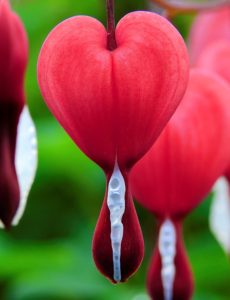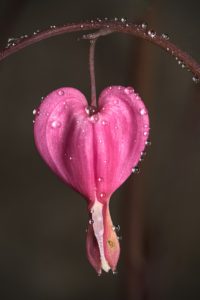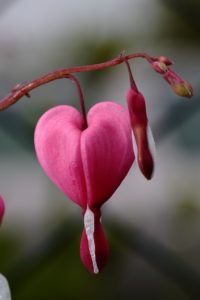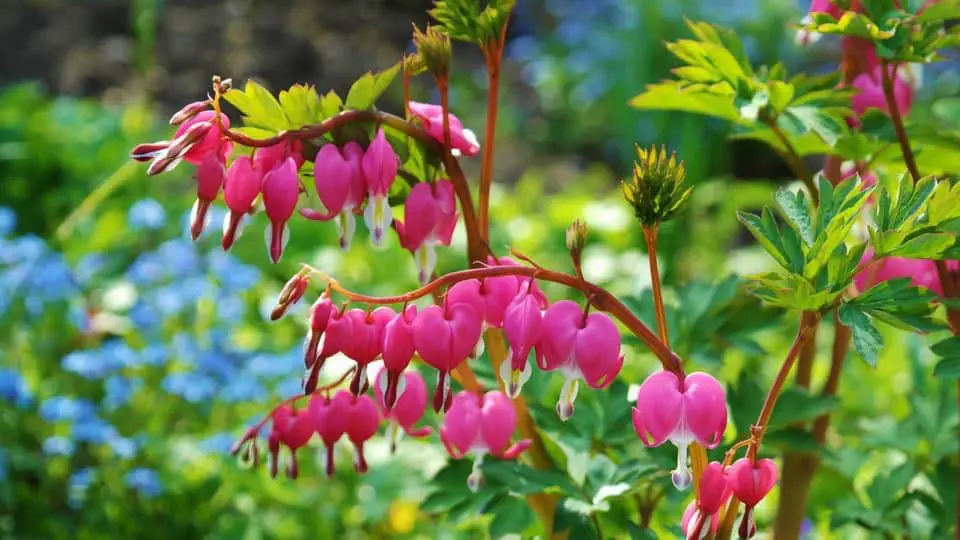Some links in the post are affiliate links and I get a commission from purchases made through some links found in the post.
The bleeding heart is a perennial plant which blooms in the spring. You will possibly have seen them in gardens where they bloom in sprays of small heart-shaped flowers on graceful bending stalks.
Typically, the bleeding heart will grow about 2-3 feet in height and produce around 20 flowers on each stem.
The plant does exceptionally well in the garden but can also be grown indoors with success. Ideally the bleeding heart needs partial shade, with about 7 hours of sunlight each day.
Some sun will be tolerated although there is a chance that the plant can overheat in excessive temperatures. This will mean that it does not produce any flowers.
Because of the graceful bending stalks, it is a huge temptation to use the bleeding heart in a hanging basket. And rightly so because they can make spectacular displays when used in the right places.
What are Perennial Plants?
 Perennials regrow every year in the spring, rather than annuals which die at the end of the season and need to be replaced in the next season.
Perennials regrow every year in the spring, rather than annuals which die at the end of the season and need to be replaced in the next season.
Bleeding hearts, along with many other beautiful garden plants, are perennials and will sprout up again for many seasons.
Perennials have a shorter flowering season than annuals so many gardeners use a combination of both annuals and perennials in their gardens.
Can Bleeding Hearts Grow in Hanging Basket?
Yes, you can grow a bleeding heart in a hanging basket as long as they get enough water and fertilizer.
Try to place the basket out of wind as not only can this dislodge the basket, but excessive wind will also cause the potting mix to constantly dry out.
You should also choose a spot where the basket will not be subjected to direct sunlight as this is bad for bleeding hearts. Rather, look for a place where it is in dappled light for most of the day.
How do you Take Care of a Bleeding Heart in a Hanging Basket?
For the bleeding heart to look its best in a container or hanging basket it needs some care when potted.
Your hanging basket will be best if placed in light shaded areas, or even in dappled sun/shade.
Make sure that the potting mixture you use drains well and water the plant regularly to prevent the mix from drying out.
You should allow the potting mix to become slightly dry between watering as this plant does not enjoy soggy roots and may well develop root rot.
A point to remember here is that any bleeding hearts which are grown in containers or hanging baskets will dry out faster than those growing in the ground.
You should use fertilizer on your bleeding heart once a month. This should be a water-soluble diluted fertilizer. It is far better to under fertilize than it is to over feed your bleeding heart.
Should I Cover my Bleeding Heart Plant?
It is a good idea when the temperatures begin to drop that you cover the stumps of the bleeding heart. By the time the winter arrives you should have pruned all the dead growth away and only have stumps left.
A layer of thick mulch to cover the area will ensure new growth the following year. The mulch also serves as insulation against frost and ice.
Even though you have cut back the dead foliage you should continue to water the base of the plants. Eventually it will all die back down to a little above the ground. Cut the plant down to about 5cm off the ground and mulch over the stump.
The rhizomes will be kept free from frost damage and grow again the following spring.
You may also like: How to plant orchids in hanging baskets
Do Bleeding Heart Plants Spread?
Bleeding hearts are classed as medium spreading plants which means that you can expect your plant to spread around 1’ – 2‘and grow to a height of 2’ – 4‘tall.
This is assuming that the growing conditions are right for them and that they are in partial shade with well-drained rich soil which is slightly damp. If these requirements are met your bleeding heart will happily seed itself for future plants.
Bleeding hearts will reach maturity in around 60 days.
Do Bleeding Hearts Need to be Cut Back in the Fall?
 Because bleeding hearts are perennials they will automatically die back at the end of the flowering season.
Because bleeding hearts are perennials they will automatically die back at the end of the flowering season.
That being said, you may want to remove the dead growth to stop pests and keep the base of the plant healthy.
Additionally, removing dead growth will leave you with a plant which looks attractive rather than looking like it is dying.
Pruning to keep the plant in shape or to get rid of excess growth does not take place with bleeding hearts as they are fairly compact. They simply need to be trimmed and dead foliage removed at the end of the season.
Can you Grow Bleeding Hearts Indoors?
Having seen bleeding hearts in their full glory in a garden, you may have wondered if you can grow this delightful plant indoors, and the answer is yes, you absolutely can.
What needs to be replicated? For bleeding hearts to do well inside you need conditions to be as close to the outside as possible. So, moist, rich soil, preferably good organic matter, and partial shade during the day.
You may find that you end up with a watering routine on every one or two days which should stop the soil from completely drying out and not leaving it boggy either.
A point to note: if the top of the soil is allowed to dry out, you will see far less blooms, and the plant may even stop blooming altogether.
Where to Place Bleeding Hearts Indoors
Depending on your house you may even be able to have these plants in a hanging basket inside.
You should make sure that the basket does not leak onto your floor so you could place a plastic sheet at the bottom.
In a pot you need to ensure that there are drainage holes at the bottom so the water can drain through. Bleeding hearts do not appreciate having wet roots.
Make sure that the basket is in a spot where it gets plenty of indirect sunlight. An option if you must place it near a window is to get a sheer curtain in the window so the light is filtered.
Because many homes are not as humid as this plant would like, you may think about a humidifier in the room where you keep the plant.
Without a humidifier you may see your plant go dormant earlier than outdoor plants and if this happens you should only water once or twice a month until it regrows.
For Either Baskets or in the Ground
There are some points which are important for your bleeding heart to do well wherever you have placed it.
- Prune often to remove the dead growth and keep the plant looking attractive.
- Fertilize once a month with a liquid-based fertilizer, starting in spring and continuing until the end of the blooming season.
- Watch the humidity levels if you keep the plant indoors. The ideal temperature for the bleeding heart is 65 degrees F.
- Dappled light is best, with very little direct sunlight.
- Watch out for root rot and make sure that any basket or container has good drainage. Dry foliage and moist soil should be your goal.
Can you Propagate your Bleeding Heart?
Yes, you can, and this is a great way to provide gifts at Christmas.
It’s very easily done:
- Make sure you use a pot with holes at the base
- Take a cutting of about 5” in length
- Make a hole with a pencil or a wooden spoon handle in the soil
- Pop in the cutting. (You can dip this into cinnamon, which is a natural propagating agent)
- Use a clear plastic bag to create a little greenhouse. Make sure there are little holes in it
- Place in indirect sunlight
- Water when needed to keep the humidity high
- Remove the plastic when you see new growth, normally in about three weeks
- Transplant to new containers when there is a good amount of new growth.
How Long do Bleeding Heart Flowers Last?
In good conditions and with the right watering routine, your bleeding heart will bloom continuously for 6-8 weeks from mid to the end of spring.
These delightful blooms will also last a long time when cut and used in flower arrangements.
Final Thoughts
 Bleeding hearts are non-aggressive and will reseed themselves if the area is moist. There are very few pests which attack them although slugs may be drawn to them.
Bleeding hearts are non-aggressive and will reseed themselves if the area is moist. There are very few pests which attack them although slugs may be drawn to them.
These can easily be removed, and the plant kept healthy for many years of production.
Bleeding hearts grow quickly and will enhance any garden or patio with their delightful heart-shaped blooms. Because they are so easy, there is no reason why your garden cannot provide a home for these beautiful plants.
With a little planning to find the right spot, they will provide pleasure for many years.
If you enjoyed this article, check out our article on what are string of hearts orange river.


